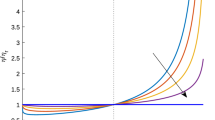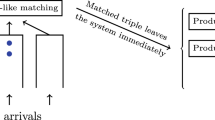Abstract
In this paper a higher order approximation for single server queues and tandem queueing networks is proposed and studied. Different from the most popular two-moment based approximations in the literature, the higher order approximation uses the higher moments of the interarrival and service distributions in evaluating the performance measures for queueing networks. It is built upon the MacLaurin series analysis, a method that is recently developed to analyze single-node queues, along with the idea of decomposition using higher orders of the moments matched to a distribution. The approximation is computationally flexible in that it can use as many moments of the interarrival and service distributions as desired and produce the corresponding moments for the waiting and interdeparture times. Therefore it can also be used to study several interesting issues that arise in the study of queueing network approximations, such as the effects of higher moments and correlations. Numerical results for single server queues and tandem queueing networks show that this approximation is better than the two-moment based approximations in most cases.
Similar content being viewed by others
References
G.A. Baker,Essentials of Padé Approximants (Academic Press, 1975).
F. Baskett, K.M. Chandy, R.R. Muntz and F.G. Palacios, Open, closed, and mixed networks of queues with different classes of customers, JACM 22 (1975) 248–260.
G.R. Bitran and S. Dasu, Approximating nonrenewal processes by Markov chains: Use of Super-Erlang (SE) chains, Oper. Res. 41 (1993) 903–923.
G.R. Bitran and S. Dasu, Analysis of the ΣPh i /Ph/1 queue, Oper. Res. 42 (1994) 158–174.
J.A. Buzacott and D.D. Yao, On queueing network models of flexible manufacturing systems, Queueing Systems 1 (1986) 5–27.
J.G. Dai, V. Nguyen and M.I. Reiman, Sequential bottleneck decomposition: An approximation method for generalized Jackson networks, Oper. Res. 42 (1994) 119–136.
D.J. Daley and T. Rolski, Light traffic approximations in queues, Math. Oper. Res. 16 (1991) 57–71.
M.K. Girish and J.Q. Hu, Higher order approximations for queueing networks, Technical Report, Dept. of Manufacturing Engineering, Boston University (April 1995).
M.K. Girish and J.Q. Hu, The departure process of the G/G/1 queue with Markov-modulated arrivals, submitted for publication in Stochas. Models.
W.B. Gong and J.Q. Hu, The MacLaurin series for the GI/G/1 queue, J. Appl. Prob. 29 (1992) 176–184.
W.B. Gong, S. Nananukul and A. Yan, Padé approximation for stochastic discrete event systems, IEEE Trans. Autom. Control, to appear.
W.J. Gordon and G.F. Newell, Closed queueing systems with exponential servers, Oper. Res. 15 (1967) 254–265.
J.M. Harrison and V. Nguyen, The QNET method for two-moment analysis of open queueing networks, Queueing Systems 6 (1990) 1–32.
J.Q. Hu, Analyticity of single-server queues in light traffic, Queueing Systems 19 (1995) 63–80.
J.Q. Hu, The departure process of the GI/G/1 queue and its MacLaurin series, Oper. Res., to appear.
J.R. Jackson, Jobshop-like queueing systems, Manag. Sci. 10 (1963) 131–142.
M.A. Johnson and M.R. Taaffe, Matching moments to phase distributions: Mixtures of Erlang distributions of common order, Stochas. Models 5 (1989) 711–743.
M.A. Johnson and M.R. Taaffe, Matching moments to phase distributions: Density function shapes, Stochas. Models 6 (1990) 283–306.
M.A. Johnson and M.R. Taaffe, An investigation of phase-distribution moment matching algorithms for use in queueing models, Queueing Systems 8 (1991) 129–148.
M.A. Johnson and M.R. Taaffe, A graphical investigation of error bounds for moment-based queueing approximations, Queueing Systems 8 (1991) 295–312.
M.A. Johnson, Selecting parameters of phase distributions: Combining nonlinear programming, heuristics, and Erlang distributions, ORSA J. Comput. 5 (1993) 69–83.
L. Kleinrock,Queueing Systems, Vol. 1 (Wiley Interscience, New York, 1975).
W. Kraemer and M. Langenbach-Belz, Approximate formulae for the delay in the queueing system GI/G/1, Proc. 8th Internat. Teletraffic Congress, Melbourne (1976) 235–248.
P.J. Kuehn, Approximate analysis of general queueing networks by decomposition, IEEE Trans. Commun. COM-27 (1979) 113–126.
M. Livny, B. Melamed and A.K. Tsiolis, The impact of autocorrelation on queueing systems, Manag. Sci. 39 (1993) 322–339.
K.T. Marshall, Some inequalities in queueing, Oper. Res. 16 (1968) 651–665.
P.P. Petrushev and V.A. Popov,Rational Approximation of Real Functions (Cambridge University Press, 1987).
L. Schmickler, MEDA: Mixed Erlang distributions as phase-type representations of empirical distribution functions, Stochas. Models 8 (1992) 131–155.
J.G. Shanthikumar and J.A. Buzacott, Open queueing network models of dynamic job shops, Int. J. Prod. Res. 19 (1981) 225–266.
R. Suri, J.L. Sanders and M. Kamath, Performance evaluation of production networks,Hand-books in OR & MS, Vol. 4 (Elsevier, 1993) pp. 199–286.
H.C. Tijms, Stochastic modelling and analysis: A computational approach (Wiley, New York, 1986).
W. Whitt, The queueing network analyzer, Bell Syst. Tech. J. 62 (1983) 2779–2815.
W. Whitt, Performance of the queueing network analyzer, Bell Syst. Tech. J. 62 (1983) 2817–2843.
W. Whitt, Approximating a point process by a renewal process, I: Two basic methods, Oper. Res. 50 (1982) 125–147.
W. Whitt, Approximations for departure processes and queues in series, Naval Res. Logistics Quarterly 31 (1984) 499–521.
W. Whitt, On approximations for queues, III: Mixtures of exponential distributions, AT&T Bell Lab. Tech. J. 63 (1984) 163–175.
D.D. Yao and J.A. Buzacott, The exponentialization approach to flexible manufacturing systems, Ann. Oper. Res. 24 (1986).
Y. Zhu and H. Li, The MacLaurin expansion for a G/G/1 queue with Markov-modulated arrivals and services, Queueing Systems 14 (1993) 125–134.
Author information
Authors and Affiliations
Rights and permissions
About this article
Cite this article
Girish, M.K., Hu, J.Q. Higher order approximations for tandem queueing networks. Queueing Syst 22, 249–276 (1996). https://doi.org/10.1007/BF01149174
Received:
Revised:
Issue Date:
DOI: https://doi.org/10.1007/BF01149174




